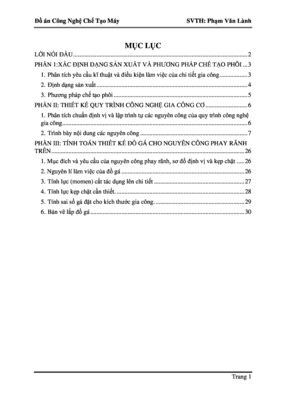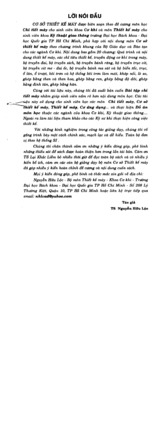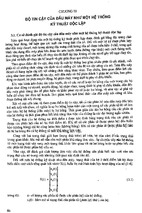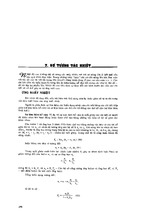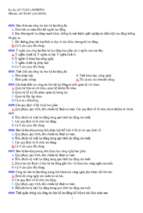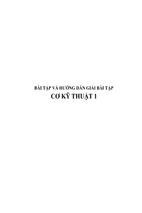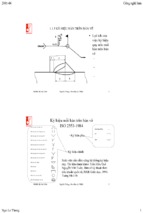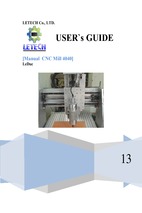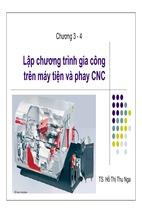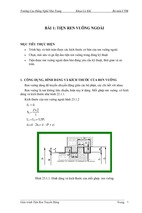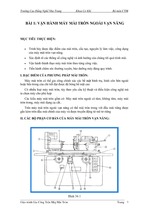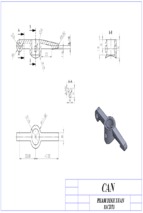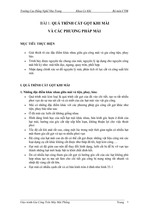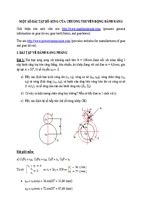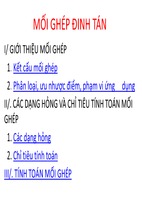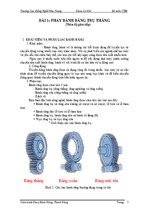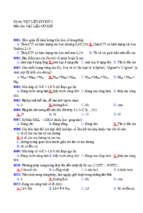Mô tả:
Adhesive Manufacturing Processes
Chapter 4:
Surface Treatment Methods
Univ.-Prof. Dr.-Ing. Prof. h.c. Stefan Böhm
Department for Cutting and Joining Manufacturing Processes (tff)
University of Kassel, Germany
Quelle: Wikipedia
Agenda
Introduction
Surface Preparation
Surface Pre-Treatment
Surface Post-Treatment
2
Introduction
Adhesion (Interface Adhesion)
● Molecular bond of the adhesive layer with the material
●
Surface of the material must be clean
●
High adhesion through large joining area
Cohesion (Cohesive Power)
●
Cohesion of the internal adhesive molecules
●
The higher the cohesion, the higher the strength
●
If the applicaion of a too thick layer is avoided, then it
can be used optimally
3
www.uhu.de
Introduction
Aims of the Surface Treatment:
● Even and very good wetting of the joint contact areas with the adhesive
● Improvement of the bond between the joint contact surfaces and the adhesive
layer
● Reproducible, longlasting adhesive bond
The creation of a surface that is suitable for adhesion is the basic prerequisite for the development
of the best possible bonding forces between the joint elements and the adhesive.
This is defined through the geometry of the surface and the physical-chemical characteristics of
the joint surfaces.
Bonding forces at
interface layer
Adhesive
Bonding forces at
inrerface layer
Joint Element
Source: Habenicht
4
Wetting
A good wetting is the prerequisite for an optimal adhesion.
Wetting is the approach of the adhesive to the joint contact area
Prerequisites for a good wetting are
● sufficient and low viscosity of the fluid adhesive
● the difference between the surface tension of the (fluid) adhesive and the surface
energy/tension joint material
The surface energy of the joint material must be higher than the surface
tension of the used adhesive, otherwise the wetting is not sufficient !
5
Wetting
Selected surface energies/tensions
Material
Surface Energy [mN/m]
Iron
2550
Titanium
2050
Copper
1850
Gold
1550
Silver
1250
PA
49-47
Epoxy Resin
47
PVC
40
PMMA
33-44
PS
33-35
PE
31
PP
29
PTFE (Teflon)
19
Typical adhesives have a surface tension
of at least 35 mN/m
Source: Bond it, S.25
6
Wetting
Test Ink – The Examination of the Surface Energy of a Solid Material
● The test ink, whose surface energy has been defined, is used to define the surface
energy of a solid object (either bigger or smaller than the test ink).
● The ink is painted onto the surface which is to be examined and then the period in
which the wetting continues is measured.
● If the wetting stays for more than 2-3 seconds, then the surface energy of the
solid object is higher than that of the ink.
Good Wetting
Bad Wetting
http://www.plasmatreat.de/
7
Wetting
Good Wetting
G
σFG
σKG
α
α
Adhesive
σKF
Joint Element
Joint Element
Wetting Surface
Bad Wetting
σFG = Surface Energy of the joint element
σKG = Surface tension of the adhesive
σKF = Tension in the boundary layer of bonding element/adhesive
α = Wetting angle
G = Air (i.e. gas atmosphere of the environment)
α
Joint Elementl
Wetting Surface
8
Surface Layers of Metaic Joint Elements
Oxide Layers
Slag Layer
Oil
Grease
Varnish
Dirt, Dust
9
Introduction
Wetting is decisive for adhesion.
Range of forces ~ 1/10 nm
10
Introduction
Classification of the Surface Treatments
Surface Treatment
Surface Preparation
Surface Pre-Treatment
Surface Post-Treatment
Cleaning
Mechanical Prep.
Climatisation
Making Fit
Physical Prep.
Application of Bonding
Agents
Degreasing
Chemical Prep.
Application of Primers
(Conservation)
Source: Habenicht
11
Agenda
Introduction
Surface Preparation
Surface Pre-Treatment
Surface Post-Treatment
12
Surface Preparation
Cleaning
● Removal of adherent, visible layers, i.e. dirt, scale,
rust, colour…
● Removal mainly mechanical: i.e. through blasting,
grinding, brushing
Source: Habenicht
13
Surface Preparation
Making Fit
● To achieve an evenly distributed layer
thickness
● i.e. through:
– Deburring of smaller joint elements
– Adjusting of bigger joint elements
● Goal is a parallel gap
thus an even force distribution
Source: Habenicht
14
Surface Preparation
Degreasing
● Is the most important step among the preparations
● Prior degreasing is necessary even for mechanical surface
pretreatments
(fat molecules could otherwise enter into joint contact area)
● Choice of degreasing method depends on:
– Number of pieces
– Geometry of the joint contact areas
– Necessary degree of absence of grease
Source: Habenicht
15
Surface Preparation
Degreasing
● Simple Degreasing
– Wiping of the surface with solvent-soaked cloth
– Immersion of the joint elements
Disadvantage: uncontrollable grease residue
● Steam Degreasing
– Condensated solvent degreases
Advantage: very free of grease
Source: Habenicht
16
Surface Preparation
Steam Degreasing
Suction
Feed
Cooling zone
for steam
condensation
Pieces that are
to be
degreased (big
pieces loosely,
smaller pieces
in baskets)
Heating
17
Surface Preparation
Degreasing
● Ultrasonic Degreasing
– Degreasing baths can be supported by ultrasound (20-40KHz)
Source: Habenicht
18
Agenda
Introduction
Surface Preparation
Surface Pretreatment
Surface Post-Treatment
19
Surface Pretreatment
Surface Treatment
Surface Preparation
Surface Pretreatment
Surface Post-Treatment
Cleaning
Mechanical Prep.
Climatisation
Making Fit
Physical Prep.
Application of Bonding
Agents
Degreasing
Chemical Prep.
Application of Primers
(Conservation)
Goal:
- Cleaning and increasing of the surface
- Increasing the surface energy
Source: Habenicht
20
- Xem thêm -


